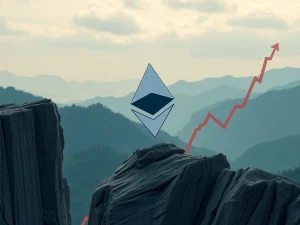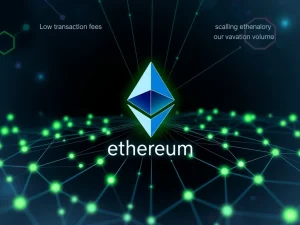Ethereum’s Crucial Crossroads: Can ETH Bulls Ignite a $5,000 Surge?

The ETH price recently saw a significant 17% weekly gain, pushing Ethereum (ETH) above $4,500. This rally has energized many in the crypto community. However, a closer look at market indicators reveals a nuanced picture. Investor sentiment, particularly in derivatives markets, remains surprisingly restrained. This raises a crucial question: how are ETH bulls truly positioned, and what challenges must they overcome to break the elusive $5,000 barrier? This article delves into the current landscape, examining blockchain competition, derivatives metrics, and the potential impact of institutional accumulation and crypto ETFs.
Ethereum’s Recent Momentum and Market Sentiment
Ethereum (ETH) surged 14% over the past seven days. This strong upward movement brought its ETH price above $4,500. It marked a two-week high for the second-largest cryptocurrency. Despite this impressive gain, a pervasive skepticism persists among traders. Derivatives indicators continue to show muted confidence. This situation leaves many wondering about the underlying factors. What is truly weighing on investor sentiment? Can ETH realistically push past $5,000 in the near term?
The 60-day futures annualized premium for ETH relative to spot markets offers insights. Monthly futures are currently trading at a 7% premium. This falls comfortably within the 5% to 10% neutral range. This range typically compensates for longer settlement periods. Notably, this specific gauge has not turned decisively bullish since February. Even a significant 100% rally in ETH earlier this year did not spark stronger confidence. That six-week rally led up to August 13. This consistent neutrality suggests caution despite price increases.
Navigating the Landscape of Blockchain Competition
Some analysts attribute ETH traders’ unease to growing blockchain competition. This is particularly true following the launch of new tokens on alternative chains. For instance, the Official Trump (TRUMP) memecoin debuted on Solana. Competitors like Solana, BNB Chain, and Tron have gained considerable traction. They offer smoother onboarding experiences for new users. Their wallets often link directly to decentralized exchanges (DEXs). In contrast, Ethereum has experienced a lag in both network fees and active addresses. This shift highlights a critical challenge for Ethereum (ETH).
The rapid growth of synthetic perpetual futures trading platforms further exemplifies this trend. Hyperliquid, for example, has emerged as a leader in this space. Instead of building on an existing layer-2 scaling solution, Hyperliquid introduced its own HyperEVM blockchain. This strategic move gained momentum. The decentralized exchange Aster, backed by YZi Labs (formerly Binance Labs), also announced plans for its own chain. These developments indicate a broader trend. Many projects now opt for independent blockchain ecosystems. This choice potentially bypasses Ethereum’s network.
Ethereum’s Dominance Amid Shifting Activity
Ethereum (ETH) still dominates in total value locked (TVL). It secures nearly $100 billion, according to DefiLlama. This leadership underscores its foundational strength in DeFi. However, network activity shows little improvement. This discrepancy is a likely factor explaining subdued ETH derivatives. Adding further pressure, fees on several Ethereum rivals have doubled in the past 30 days. This trend erodes ETH‘s relative appeal. Lower fees on competing chains attract users and projects.
Nansen data reveals significant shifts. Ethereum‘s network fees dropped 30% over the past month. Concurrently, transactions declined by 10%. This contrasts sharply with other blockchains. Fees on BNB Chain, Avalanche, and HyperEVM doubled. Their transaction counts surged by 60% or more during the same period. Even though deposits in Ethereum smart contracts rose 5% this month, traders remain concerned. They worry that competitors are steadily closing the gap. This growing blockchain competition poses a long-term challenge.
Within Ethereum‘s TVL growth, some protocols stand out positively. Ethena, a synthetic stablecoin protocol, gained 18% over the past 30 days. Spark, a DeFi platform focusing on lending and stablecoin yields, saw deposits rise 28%. Conversely, TVL on the Pendle yield platform dropped 50%. Deposits on the lending platform Morpho also declined 8%. These mixed results reflect a dynamic and competitive ecosystem. They show varied performance among decentralized applications on Ethereum.
Derivatives Outlook and the Path to Institutional Accumulation
The ETH options delta skew provides another critical metric. This put-call indicator at Deribit has remained within a neutral band of +6% to -6%. This range suggests that put (sell) and call (buy) options are trading at comparable levels. Had traders grown more optimistic, demand for bullish strategies would have pushed the indicator lower. Such a significant shift has not yet occurred. This neutral stance reflects ongoing market caution regarding the ETH price trajectory.
Furthermore, ETH traders may feel uneasy about potential spot crypto ETFs for other altcoins. The US Securities and Exchange Commission (SEC) is considering these. Analysts predict approval odds above 95% for Solana, Litecoin, and XRP in October. Such an outcome could strengthen these networks significantly. Consequently, it would heighten blockchain competition across the broader altcoin market. This potential scenario adds another layer of uncertainty for Ethereum (ETH).
Ethereum‘s next significant leg higher will likely hinge on sustained institutional accumulation. This includes investments through spot crypto ETFs. Moreover, companies adopting ETH as a reserve asset could provide a major boost. Bitmine Immersion Tech (BMNR) offers a compelling example. The company alone added nearly $12 billion in Ethereum (ETH). They achieved this by issuing debt and selling stock. Such activity could spark a significant supply shock. This, in turn, could propel the ETH price beyond $5,000.
Conclusion: Ethereum’s Dual Challenge and Opportunity
Ethereum (ETH) stands at a pivotal juncture. Its recent ETH price surge demonstrates underlying strength. However, the network faces intense blockchain competition and restrained derivatives sentiment. The path to breaking $5,000 appears to depend heavily on external catalysts. Institutional accumulation through crypto ETFs and corporate adoption could provide the necessary impetus. This could potentially trigger a supply shock. While challenges persist, the potential for significant growth remains. Investors are closely watching these developments. The future trajectory of Ethereum will be shaped by its ability to adapt and attract large-scale capital.









